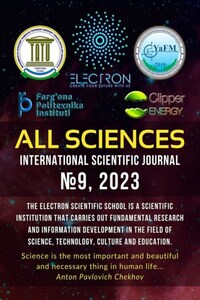Ferghana State University, Ferghana, Uzbekistan
Annotation. This study analyzes modern achievements of science and technology on the way to explore the largest and most massive object in the Solar System, except for its star, the planet Jupiter. Much attention is paid to the analysis of its internal structure and the environment prevailing there, along with a parallel analysis of the possibilities of technologies for exploring the planet under specified physical conditions.
Keywords: Jupiter planet, gas giant, environment, physical and mathematical modeling, research, analysis.
Аннотация. В настоящем исследовании проводиться анализ современных достижений науки и техники на пути исследования самого большого и массивного объекта в Солнечной системы, кроме её звезды – планеты Юпитер. Большое внимание уделяется анализу его внутренней структуры и царящей там среды, наряду с параллельным анализом возможностей технологий для исследования планеты при обозначенных физических условиях.
Ключевые слова: планета Юпитер, газовый гигант, среда, физико-математическое моделирование, исследование, анализ.
The planet Jupiter, which is the second largest, after the Sun in terms of size and volume of objects in the Solar System, appears as a rather interesting object to study, along with a variety of space objects. So, it was this planet, discovered by the brilliant scientist Galileo Galilei, that became one of the key reasons for the collapse of the geocentric theory, as well as the clearest proof that not all objects in the system revolve around the Earth or the Sun, which in turn struck a blow towards the heliocentric system. Jupiter has a huge number of very different satellites and today more than 80 satellites are known, but the first of them were discovered precisely the so – called Galileo satellites, named by his German colleague – Ganymede, Europa, Io and Calisto.
Jupiter is a gas giant, unlike other planets with a solid surface, surrounded by a large thick atmosphere. This was also the reason that this planet is home to the largest hurricane in the entire Solar System, the size of planet Earth, called the «Big Red Spot» and which has been going on for hundreds of years and besides, the wind speed in it reaches 650 km/h or 350 knots. It is also worth noting that only in its small diameter, because it has the shape of an ellipsoid, it is approximately equal to the Earth, and its larger diameter is relatively larger than the diameter of the Earth.
It is interesting to establish the initial connection with the planet directly, namely, the process of transferring from the optical part of the spectrum to the radio wave, one can see the radiation of the planet’s magnetic field formed in a powerful magnetosphere. So, the first information about this radiation was received from Pioneer-10 on March 12, 1973, after which all models were equipped with a powerful safety system against strong electromagnetic radiation, but the next obstacle is a powerful atmosphere, even more significant in its danger than the danger of the electromagnetic background.
For the first time, the Galileo spacecraft succeeded in penetrating the planet’s atmosphere on December 8, 1995, when its expedition was launched and for 8 years this device has been transmitting information about the analysis of both the planet itself and satellites. So, its first satellite Io is a very tectonic space object with a large number of volcanoes and slightly larger than the Moon, in contrast to the calm and snowy Europe, under which there is supposed to be a huge ocean. There are suggestions that real life can live in this liquid icy water.








